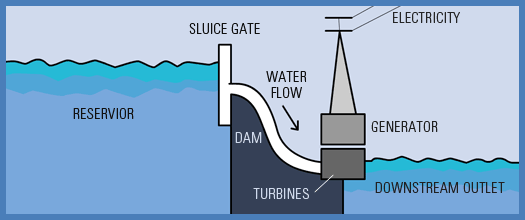Hydro-power (water) is one of the older electricity generating technologies around. It uses the concept of kinetic energy in fast flowing water. In ancient Greece, wheat wheels were used in farm hoses to mill wheat into flour. This concept remains the same, but the technology has changed a lot.
Typically, a flowing river, stream or canal is blocked (dam) at a strategic point, usually at a waterfall point, with the intention of holding the water back and storing the water in a reservoir. The weight of the water that is held by the dam increases to a certain level and then released by opening the gates (Sluice gate). The high-pressure water flowing downwards is used to turn a series of blades or shafts in a generator made of coils and magnets. Electricity is generated. The amount of power generated depends on how high the water is held upstream, the amount of water turning the shafts and the general efficiency of the turbines.

Hydropower installations come in various sizes, but classified in 3 major sizes:
1. Micro Hydro Power: Capacity of up to 100kilowatts, usually installed to power homes or farms
2. Small Hydro Power: Capacity of 100kilowatts up to 30 megawatts.
3. Large Hydro Power: Capacity of more than 30 megawatts
Hydro energy is renewable in the sense that the water will not run out as long as water cycle exists. It is also renewable because it has no carbon emissions in its production. However, it is known to have some negative impact on water life and plants in the water, and also, there are specific places along the river that can be dammed. Unlike solar energy, water energy installations may not be available to countries with no fast flowing water.
It is worth noting that not all dams generate power. Dams may be built for various reasons such as recreation, farm ponds, irrigation or water supply.
On a global scale, leading hydro-power generation countries include China, Brazil, USA, Canada and Russia, and together they hold about more than half of the world’s hydropower capacity. In the United States, hydropower makes up about 9% of the total electricity supply. ‘The largest hydroelectric plant in the United States is at Grand Coulee Dam. Its three power plants have a capacity of 6,809 MW, and it generates, on average, about 21 billion KWh’ Source: US Department of the Interior.
